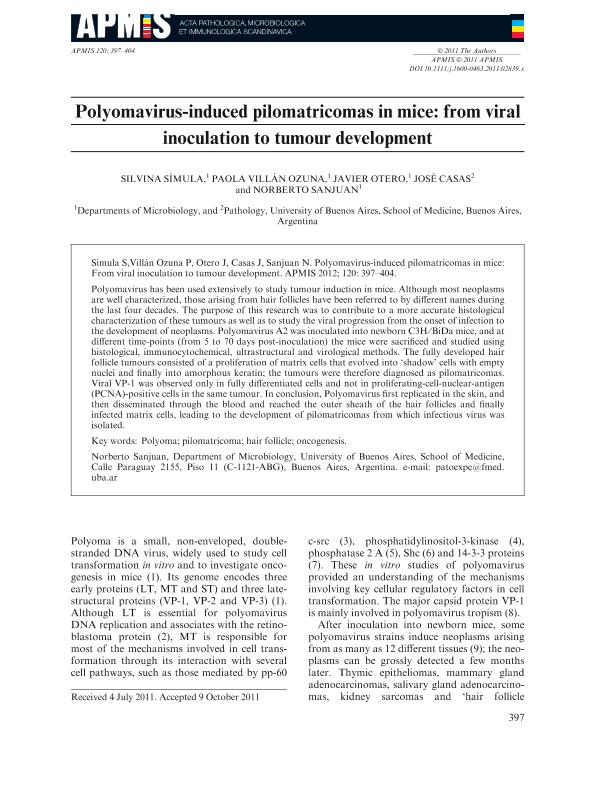Artículo
Polyomavirus-induced pilomatricomas in mice: From viral inoculation to tumour development
Fecha de publicación:
05/2012
Editorial:
Wiley Blackwell Publishing, Inc
Revista:
Apmis
ISSN:
0903-4641
Idioma:
Inglés
Tipo de recurso:
Artículo publicado
Clasificación temática:
Resumen
Polyomavirus has been used extensively to study tumour induction in mice. Although most neoplasms are well characterized, those arising from hair follicles have been referred to by different names during the last four decades. The purpose of this research was to contribute to a more accurate histological characterization of these tumours as well as to study the viral progression from the onset of infection to the development of neoplasms. Polyomavirus A2 was inoculated into newborn C3H/BiDa mice, and at different time-points (from 5 to 70days post-inoculation) the mice were sacrificed and studied using histological, immunocytochemical, ultrastructural and virological methods. The fully developed hair follicle tumours consisted of a proliferation of matrix cells that evolved into 'shadow' cells with empty nuclei and finally into amorphous keratin; the tumours were therefore diagnosed as pilomatricomas. Viral VP-1 was observed only in fully differentiated cells and not in proliferating-cell-nuclear-antigen (PCNA)-positive cells in the same tumour. In conclusion, Polyomavirus first replicated in the skin, and then disseminated through the blood and reached the outer sheath of the hair follicles and finally infected matrix cells, leading to the development of pilomatricomas from which infectious virus was isolated. © 2011 The Authors. APMIS © 2011 APMIS.
Palabras clave:
Hair Follicle
,
Oncogenesis
,
Pilomatricoma
,
Polyoma
Archivos asociados
Licencia
Identificadores
Colecciones
Articulos(IMPAM)
Articulos de INSTITUTO DE INVESTIGACIONES EN MICROBIOLOGIA Y PARASITOLOGIA MEDICA
Articulos de INSTITUTO DE INVESTIGACIONES EN MICROBIOLOGIA Y PARASITOLOGIA MEDICA
Citación
Simula, Silvina; Ozuna, Paola Villán; Otero, Javier; Casas, José; Sanjuan, Norberto Aníbal; Polyomavirus-induced pilomatricomas in mice: From viral inoculation to tumour development; Wiley Blackwell Publishing, Inc; Apmis; 120; 5; 5-2012; 397-404
Compartir
Altmétricas




